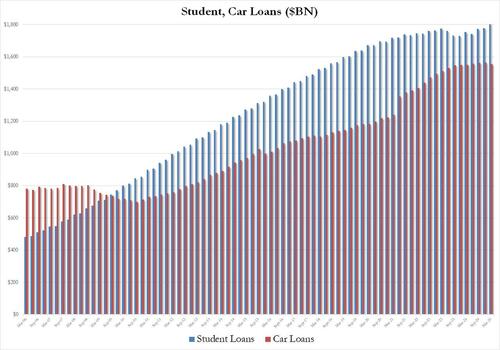Do They Deserve It? Mexico Is Collapsing As The US Deports Illegals Back Home
Authored by Brandon Smith via Alt-Market.us
Oh, the delicious irony. For many years I’ve been writing about the southern US border and the many ways in which Mexico has used it as a “steam valve” to get rid of people in perpetual poverty, as well as malcontents, violent criminals and political revolutionaries. Who could have foreseen a time when the conundrum would be reversed and Mexico would be crushed by an avalanche of its own unwanted citizens?
But weren’t we told that migrants are an “economic boon” to any country lucky enough to have them?
The argument among progressives and open border activists has always been that migrants are average law abiding people (just like us) who slip across the border simply to integrate into our society and live the American dream. They claim that Mexican leaders are not in control of the situation and that people are desperate to escape crime and social decline.
In reality, government officials have long encouraged migrant caravans to traverse their territories and they have allowed illegal immigration into the US as a means to divert their failures into the laps of American taxpayers. Migrants aren’t trying to escape problems in Mexico, they ARE the problem in Mexico. The more of these caravans the Mexican authorities can get rid of, the better their economic situation appears.
I wrote about this dynamic in detail in my recent article ‘Illegal Alien Economy: How Foreign Nations Exploit U.S. Borders For Profit’. Specifically, I examined threats made by Mexican President Claudia Sheinbaum over the possible taxation of remittances (US dollars) sent by migrants from the US into the coffers of Mexican banks and households.
She asserted that her government would “mobilize” against the US should conservative politicians continue their campaign to stop illegals from transferring money back home. Remittances are the single largest source of revenue Mexico receives from foreign countries. Their economy loses significantly without this cash flow.
Beyond the issue of easy money, though, is a singular reality which I have reiterated for a long time: Central and South American nations cannot survive the influx of returning migrants. They will be suffocated by the very same illegals they originally foisted upon the US.
The purging of millions of undesirables reduces Mexico’s poverty stats, homeless stats, unemployment stats and crime stats. I have to laugh every time I hear smug Europeans criticize the US for our violent crime rates – Only now are they beginning to understand what happens when you overwhelm a western nation with a third world demographic and a third world mentality. We certainly have our own home brewed fatigue-ers, but taking on millions of fatigue-ers from other nations does not help.
It’s difficult to keep crime low when other countries offload their problem children onto your front lawn.
Furthermore, labor data proves that illegals have been stealing American jobs and driving down American wages. It’s no coincidence that employment numbers for native born Americans have spiked in recent months as migrant jobs have decreased in tandem with deportations.
There’s a lot more proof in the pudding when we examine what is currently happening in Mexico, though.
Riots in Mexico city are breaking out and they are growing more violent by the day. Residents blame “gringo immigrants” and “digital nomads” for moving into the country and driving up food and housing costs. They also complain that white visitors are allowed to stay on their visas for far too long and that they refuse to “learn their language or respect Mexican culture”. Gee, that sure sounds familiar. Has Mexico gone MAGA?
The irony is, of course, that conservative Americans have been warning about the same issues caused by migrants from Mexico and we have been called “racists” and “fascists” for doing so.
There are approximately 700,000 US citizens residing in Mexico today, a tiny number compared to the tens of millions of Mexican migrants in the US illegally. But somehow, gringos are to blame for rising prices?
Realty experts in the Mexican market say that the cause of the shortages is a slowdown in housing development (Didn’t they tell us we needed illegals to help build more houses to counter the housing shortage in the US? Why don’t they put all these returning construction supermen to work in Mexico?). This explanation doesn’t account for inflation in other areas of the economy such as food and energy. So, are white tourists and ex-pats making things more expensive south of the border?
No, this is nonsense. Perhaps in a handful of resort towns the case might be made, but the truth is that Mexicans are being propagandized into thinking US migrants are the cause of their woes when it is actually the mass return of their OWN CITIZENS from the US.
Some of these people have been deported by force, but armies of them are self deporting and the Mexican economy simply can’t handle the strain. The surge started in 2024, even before Trump took office, with many illegals leaving the US because of inflation as well as the expectation of a conservative election win.
The riots, though, are probably starting now because of the mass deportations. Mexico City in particular has been inundated with migrants, many of them from other countries in Central and South America, as they look for a new place to settle outside the US.
I’ll say it again – I believe the Mexican population is being agitated into violence against American visitors by false claims that they are driving up prices when it is returning illegals that are the real cause. Mexican leaders are trying to distract their population from the bigger picture.
To be sure, there is obviously the NGO issue to consider. Central and South American leaders have not been acting unilaterally as they push for open US borders. Globalist organizations have been expediting matters by feeding cash into programs that guide illegals into the US. They do this to further their vision of a borderless multicultural world, but also to destabilize western societies and displace groups of people they see as likely threats in the future (namely white Christian conservatives).
However, globalist non-profits only smooth the way; its governments like the variety in Mexico that have been providing the human bodies for the NGOs to work with.
Now that Mexico is witnessing the pure Karma of their actions, what is likely to happen? First, the Mexican economy is going to go into a tailspin in a very short period of time. Prices will skyrocket due to crushing demand as illegals come home (just as they helped to trigger rising prices in the US during the Biden border bonanza).
Second, unemployment will rise exponentially along with a saturated labor market. High competition for limited jobs will force government intervention. But in Mexico the government has far less means at its disposal to adapt to the chaos of mass immigration. They will seek to establish social programs to gloss over the damage, but this will fail. Not only are they taking on millions of citizens that they tried to get rid of, they are losing access to the billions of US dollars those migrants were injecting into the Mexican economy. It’s a double whammy.
Third, Mexican officials will demonize the US for the deportations, as if it’s our fault they sent so many foreigners into our country without our permission. As we have seen, this is already leading to animosity across the border and Americans will remain at risk when they travel.
Fourth, if the current trend continues, Mexico will face economic collapse. They simply won’t be able to mitigate the instability caused by the sudden surge in inflation, housing shortages and the unemployed feeding on their social welfare programs.
What would this means for the US? Riots and violence in Mexico could bleed over into border states. Near zero infrastructure on the Mexican side of the border and even less restrictions on migrant movements, which means even tighter controls will be needed on the US side to keep illegals in check. Cartels may end up being the least of our worries when it comes to threats from Central America.
Keep in mind that a large contingent of Central Americans believe that the southern US belongs to them by historical right. The “La Raza” movement has long called for the retaking of large swaths of US territory in the name of “decolonization” (even though they are also descended from Spanish colonists). I believe they will once again assume that they can solve most of their problems of incompetent governance and economic decline by blaming the US and pressing citizens to invade.
They will double down on the same actions that got them in trouble in the first place. When Claudia Sheinbaum talks about “mobilizing” Mexico against the US, this is most likely what she means – A renewed march on the US border in the hopes that Mexico can reopen the steam valve and alleviate their economic troubles.
The result will not be peaceful as she seems to suppose; it could even mean war. It would be a disaster for the Mexicans, but they’ve been relying on the US for so long that they simply don’t understand any other way. That is to say, they are about to get what they deserve; a taste of their own medicine. The destabilization they tried to export to us is now on its way to blow up their own country.
Tyler Durden Tue, 07/08/2025 - 23:25


 (Image by metamorworks via Shutterstock)
(Image by metamorworks via Shutterstock) Centaur could mark a new turning point in AI in its unprecedented ability to understand the human mind. (Image by Shutterstock AI Generator)
Centaur could mark a new turning point in AI in its unprecedented ability to understand the human mind. (Image by Shutterstock AI Generator) via Tehran Times
via Tehran Times


 The main building at Penn State Great Valley School of Graduate Professional Studies in Malvern, Pa., in September 2018. Facing a $29 million deficit, Pennsylvania university system trustees announced May 22, 2025, that seven campuses will close within two years, with five more at risk if enrollment doesn’t rise. David Kriz/CC BY-SA 4.0
The main building at Penn State Great Valley School of Graduate Professional Studies in Malvern, Pa., in September 2018. Facing a $29 million deficit, Pennsylvania university system trustees announced May 22, 2025, that seven campuses will close within two years, with five more at risk if enrollment doesn’t rise. David Kriz/CC BY-SA 4.0 Several colleges recently announced they are closing, including St. Andrews University in North Carolina, Limestone University in South Carolina, Eastern Nazarene College in Massachusetts, Fontbonne University in Missouri, and Northland College in Wisconsin. official college websites/Screenshot via The Epoch Times
Several colleges recently announced they are closing, including St. Andrews University in North Carolina, Limestone University in South Carolina, Eastern Nazarene College in Massachusetts, Fontbonne University in Missouri, and Northland College in Wisconsin. official college websites/Screenshot via The Epoch Times

 Via AFP
Via AFP
 Screen grab from video allegedly showing a public beheading in Saudi Arabia. (YouTube/tnycman)
Screen grab from video allegedly showing a public beheading in Saudi Arabia. (YouTube/tnycman)




 Getty Images
Getty Images
Recent comments